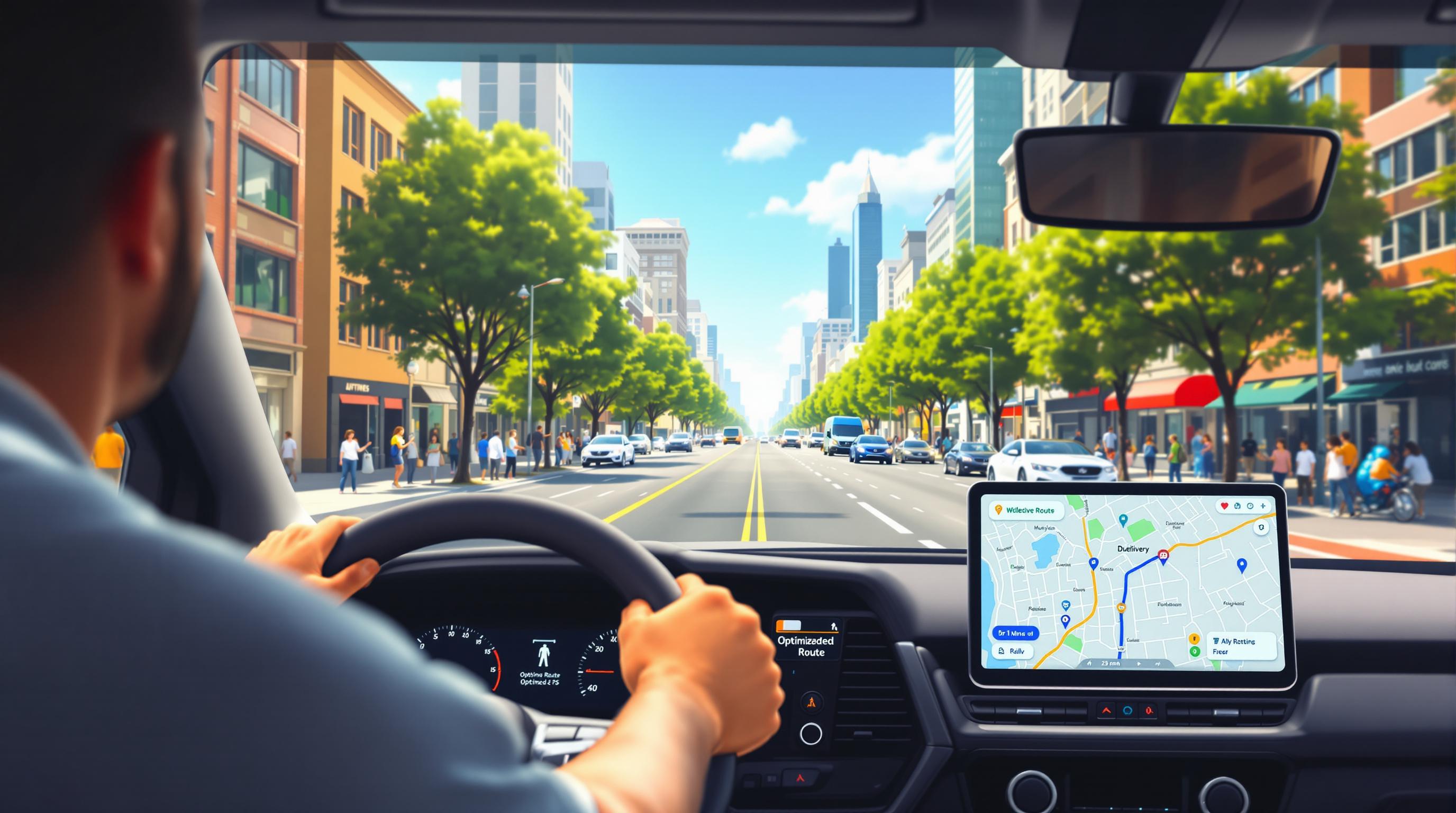Real-time route planning uses live traffic, weather, and schedule updates to make routes more efficient. Unlike static plans, it adjusts instantly to changes, saving time, cutting costs, and improving customer satisfaction.
Why It Matters:
- Save Time: Avoid traffic and delays with AI-powered updates.
- Reduce Costs: Lower fuel use and vehicle wear with smarter routes.
- Improve Service: Provide accurate ETAs and respond faster to urgent requests.
Key Features:
- Live traffic and weather updates.
- AI recalculations for disruptions like road closures.
- Dynamic scheduling for last-minute changes.
Switching to real-time routing ensures smoother operations, happier customers, and lower costs. Let’s explore how it works and why it’s better than static planning.
Main Advantages of Real-Time Route Planning
Improved Route Efficiency
AI-powered adjustments allow routes to change on the fly based on traffic, weather, or unexpected schedule updates, helping to avoid unnecessary delays.
Field service teams benefit by being able to:
- Adjust Quickly: Modify routes immediately when new service calls are added.
- Bypass Problems: Navigate around roadblocks like accidents or construction.
- Save Time: Choose quicker alternate routes based on current road conditions.
- Even Out Workloads: Reassign tasks when technicians are delayed or finish ahead of schedule.
Reduced Operational Costs
Ongoing route adjustments help cut expenses by:
- Reducing fuel usage through smarter navigation.
- Cutting down overtime with better scheduling.
- Minimizing vehicle wear by avoiding inefficient routes.
- Decreasing idle time between appointments.
Enhanced Customer Experience
Real-time routing ensures accurate arrival times and faster responses, building stronger relationships with clients by:
- Providing Accurate ETAs: Keep customers informed with real-time arrival updates.
- Quickly Handling Urgent Requests: Respond more effectively to last-minute needs.
- Offering Scheduling Flexibility: Adapt to changes in appointments with ease.
- Sending Proactive Alerts: Notify customers about delays before they become an issue.
Next, dive into the data sources and AI technology that make these updates possible.
Real-Time Data Systems Explained
Data Sources
Real-time data systems rely on inputs like vehicle GPS, traffic updates, weather conditions, and appointment changes. These live data streams feed directly into AI systems, providing the information needed for dynamic route optimization.
How AI Updates Routes
AI engines process these continuous data streams to identify disruptions, adjust routes, update ETAs, and reorganize stop sequences - all in real time. This ensures routes remain efficient and responsive to changing conditions.
AI-Driven Logistics and Route Optimization Techniques #ai ...
sbb-itb-7020db0
Steps to Use Real-Time Route Planning
Ready to make your routes smarter? Follow these three steps: identify issues, implement AI solutions, and monitor progress.
Identify Current Challenges
Start by pinpointing your biggest pain points, like delivery delays or high fuel expenses. Set clear, measurable goals to tackle these issues.
Implement AI Route Planning
Sign up with Routemize for AI-powered route optimization. Their system adjusts routes in real time based on live traffic and schedule data, helping reduce travel time and keep everything running smoothly.
Monitor and Analyze Results
Track how your delays and fuel consumption stack up against your goals. Review your progress weekly to spot areas where you can improve even more.
Up next, compare static routing with real-time updates to see why staying dynamic makes all the difference.
Static vs. Real-Time Route Planning
Now that we've gone over the implementation steps, let's dive into how static route planning stacks up against real-time alternatives. By revisiting AI triggers and data feeds, we can see how these two approaches handle routing challenges differently.
Static route planning sticks to fixed schedules and pre-set paths that don’t change throughout the day. While it may work in predictable environments, it struggles to address issues like traffic jams, last-minute changes, or rising customer demands.
Here’s how static and real-time planning differ:
- Traffic Handling: Static routes don’t account for traffic, while real-time systems adjust on the fly.
- Flexibility: Fixed schedules need manual intervention to update, but real-time systems adapt instantly.
- Visibility: Traditional planning lacks transparency, whereas real-time systems provide live ETAs and alerts.
Real-time planning takes operations to the next level by constantly adjusting to new conditions. For example, if there’s a road closure or a client reschedules, the system recalculates the route immediately to keep things running smoothly.
Tools like Routemize make this possible by using live traffic data and appointment updates to ensure routes stay efficient, even as things change. This way, businesses can save time and reduce unnecessary travel, keeping both operations and customers satisfied.
Conclusion: Business Benefits of Real-Time Planning
Switching from static to real-time routing offers clear advantages for businesses:
Real-time planning helps cut fuel consumption and driving time, reducing costs for each vehicle. Features like automatic ETA updates and adaptable schedules improve service reliability, build trust, and enhance customer retention. Over time, AI uses historical data to identify patterns and improve routes without adding to operational expenses.
Routemize's AI platform processes live traffic and appointment data instantly, minimizing travel time and keeping operations efficient, even during unexpected delays.
FAQs
How can businesses use real-time data to optimize their route planning?
Integrating real-time data into route planning helps businesses streamline operations by reducing delays, improving efficiency, and making smarter decisions. By analyzing factors like live traffic conditions and appointment locations, businesses can create more dynamic and adaptive routes.
With tools like AI-driven route optimization, companies can minimize travel time, allowing teams to spend less time on the road and more time focusing on their clients. This approach not only boosts productivity but also enhances customer satisfaction by ensuring timely arrivals and efficient service.
What technologies and data are crucial for real-time route optimization?
Real-time route optimization relies on advanced AI algorithms and up-to-date data sources to deliver accurate and efficient results. Key technologies include real-time traffic analysis, GPS tracking, and predictive analytics. These systems evaluate factors like current road conditions, traffic patterns, and appointment locations to create the most efficient routes.
By leveraging these tools, businesses can reduce delays, save time, and make smarter decisions, ensuring smoother operations and better service for their clients.
What challenges do businesses face when switching from static to real-time route planning?
Transitioning from static to real-time route planning can present several challenges for businesses. One common issue is managing the integration of real-time data, such as traffic updates and weather conditions, into existing systems. This often requires updating or replacing outdated technology, which can be time-consuming and costly.
Another challenge is the need for staff training to effectively use new tools and processes. Employees may need time to adapt to dynamic route adjustments and learn how to interpret real-time data for decision-making. However, overcoming these hurdles can lead to significant benefits, such as reduced delays, improved efficiency, and better service for clients.


